F1554 anchor bolts are manufactured in a wide range of configurations. The project engineer specifies the required grade, size, and configuration of an F1554 anchor bolt based on the application and the forces acting against it. The various manufacturing processes required to produce F1554 anchor bolts are described below.
Cutting
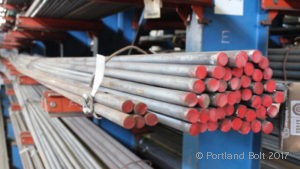 Steel rolling mills melt and roll steel round bar in lengths of 20’ – 40’ in various diameters and grades. The first manufacturing operation required, regardless of what type of anchor bolt is being manufactured, is to cut the round bar to the desired length. Depending on the diameter, grade of steel, and the quantity being cut, steel for F1554 anchor bolts can be either sheared to length or cut using a band saw. Shears chop the steel like a guillotine and are very efficient compared to band saws that use blades with teeth to cut through the steel. Using shears to cut round bar is limited to 2” in diameter depending on grade and lengths of about 8’ – 9’ feet roughly, while band saws essentially have no limitations on diameter or length.
Steel rolling mills melt and roll steel round bar in lengths of 20’ – 40’ in various diameters and grades. The first manufacturing operation required, regardless of what type of anchor bolt is being manufactured, is to cut the round bar to the desired length. Depending on the diameter, grade of steel, and the quantity being cut, steel for F1554 anchor bolts can be either sheared to length or cut using a band saw. Shears chop the steel like a guillotine and are very efficient compared to band saws that use blades with teeth to cut through the steel. Using shears to cut round bar is limited to 2” in diameter depending on grade and lengths of about 8’ – 9’ feet roughly, while band saws essentially have no limitations on diameter or length.
Threading
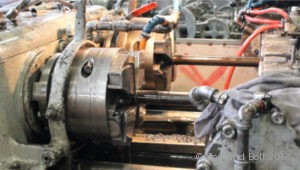 Virtually all F1554 anchor bolts, regardless of their final manufactured configuration, will need a threaded end that will project from the concrete to allow for the structure to be attached to the foundation with a nut. These threads are commonly created with two types of threading processes. Cut threading, which removes steel from the round bar, is common for small quantities of anchor bolts, large diameters, long threads, and high strength anchor bolts. Thread rolling forms threads through an extrusion process in which threading dies displace the steel to form the thread. Many straight rods being used as anchor bolts have a thread at the embedded end that may have a welded nut, welded plate, or a combination of nuts and a plate to increase pullout resistance.
Virtually all F1554 anchor bolts, regardless of their final manufactured configuration, will need a threaded end that will project from the concrete to allow for the structure to be attached to the foundation with a nut. These threads are commonly created with two types of threading processes. Cut threading, which removes steel from the round bar, is common for small quantities of anchor bolts, large diameters, long threads, and high strength anchor bolts. Thread rolling forms threads through an extrusion process in which threading dies displace the steel to form the thread. Many straight rods being used as anchor bolts have a thread at the embedded end that may have a welded nut, welded plate, or a combination of nuts and a plate to increase pullout resistance.
Heading
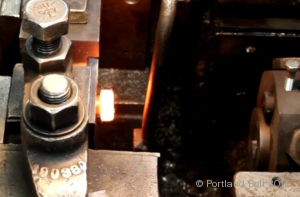 Instead of a bend, welded nut, or plate, some anchor bolts have a forged head on the embedded end that creates the needed pull-out resistance. The unthreaded end of the round bar is heated to a high temperature and then is “upset”/forged in an operation that shapes the heated end into a hex, heavy hex, or square head shape. Headed F1554 anchor bolts can commonly be manufactured through 2½” diameter and Portland Bolts stocks headed blanks in F1554 Grade 36 and F1554 Grade 55 for quick manufacturing lead times. Headed F1554 Grade 36 anchor bolts are also stock items from ½” – 1” diameter in a variety of lengths.
Instead of a bend, welded nut, or plate, some anchor bolts have a forged head on the embedded end that creates the needed pull-out resistance. The unthreaded end of the round bar is heated to a high temperature and then is “upset”/forged in an operation that shapes the heated end into a hex, heavy hex, or square head shape. Headed F1554 anchor bolts can commonly be manufactured through 2½” diameter and Portland Bolts stocks headed blanks in F1554 Grade 36 and F1554 Grade 55 for quick manufacturing lead times. Headed F1554 Grade 36 anchor bolts are also stock items from ½” – 1” diameter in a variety of lengths.
Bending
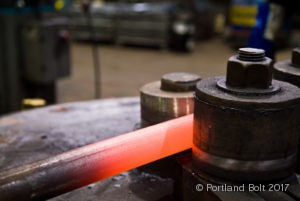 Right angle bend, or 90-degree angle bend, anchor bolts are a common configuration for F1554 anchor bolts, especially in smaller diameter/lengths and in typical standard sizes. Powerful bending equipment is used to produce a bent portion or “hook” on the unthreaded end that will be embedded in the concrete. In this instance, it is the bent portion of the anchor bolt that provides the pull-out resistance rather than a forged head or welded nut.
Right angle bend, or 90-degree angle bend, anchor bolts are a common configuration for F1554 anchor bolts, especially in smaller diameter/lengths and in typical standard sizes. Powerful bending equipment is used to produce a bent portion or “hook” on the unthreaded end that will be embedded in the concrete. In this instance, it is the bent portion of the anchor bolt that provides the pull-out resistance rather than a forged head or welded nut.
Chamfering
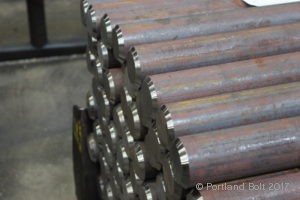 Removing the first thread of the threaded portion of an anchor bolt ensures easy use with a nut and helps eliminate installation problems. This process is called chamfering. Chamfering is especially important for high strength or galvanized anchor bolts and helps facilitate the assembly of a nut by applying a slight bevel to the threaded end removing the incomplete or sharp first thread that often can be easily damaged/bent.
Removing the first thread of the threaded portion of an anchor bolt ensures easy use with a nut and helps eliminate installation problems. This process is called chamfering. Chamfering is especially important for high strength or galvanized anchor bolts and helps facilitate the assembly of a nut by applying a slight bevel to the threaded end removing the incomplete or sharp first thread that often can be easily damaged/bent.
Swedging
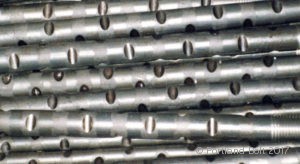 F1554 anchor bolts can also be swedged/pressed with large indentations or dimples that allow concrete, grout, or epoxy to fill into the indentations. The concrete, grout, or epoxy forms around the indentations and this creates pullout resistance instead of a welded nut or forged head. These type of anchor bolts are referred to as swedged anchor bolts and are often used in bridge bearing assemblies.
F1554 anchor bolts can also be swedged/pressed with large indentations or dimples that allow concrete, grout, or epoxy to fill into the indentations. The concrete, grout, or epoxy forms around the indentations and this creates pullout resistance instead of a welded nut or forged head. These type of anchor bolts are referred to as swedged anchor bolts and are often used in bridge bearing assemblies.
Welding
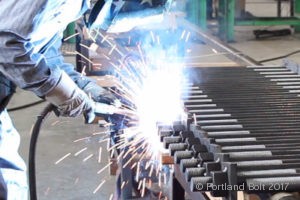 Welding is a process in which pieces of steel are bonded together by heating the components and combining a filler material of molten metal. It is very common for F1554 anchor bolts and rods to be welded for many different reasons. A welded nut at the bottom of a rod, fillet welded plates, welded pipe sleeves, and any combinations thereof are very common for F1554 anchor bolts. F1554 Grade 36 is always weldable and F1555 Grade 55 has a supplemental requirement for weldability that is very common, however significant welding to F1554 Grade 105 should be questioned since this grade is heat treated and may be unpredictably altered by applying high heat.
Welding is a process in which pieces of steel are bonded together by heating the components and combining a filler material of molten metal. It is very common for F1554 anchor bolts and rods to be welded for many different reasons. A welded nut at the bottom of a rod, fillet welded plates, welded pipe sleeves, and any combinations thereof are very common for F1554 anchor bolts. F1554 Grade 36 is always weldable and F1555 Grade 55 has a supplemental requirement for weldability that is very common, however significant welding to F1554 Grade 105 should be questioned since this grade is heat treated and may be unpredictably altered by applying high heat.
Plate Fabrication
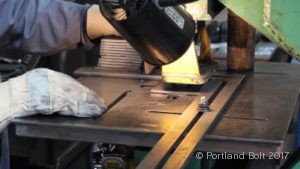 Anchor plates for the embed end of an anchor bolt are very common. They can be round, square or rectangular in shape and are often welded or assembled to the embedded end of F1554 anchor rods and bolts to provide pull-out resistance. These plates may also be used on the top of the projecting end as large washers. Templates made from steel are also utilized to properly space the anchor bolts during installation and during concrete placement. Plates and templates can be laser-cut, plasma burnt, or sheared/punched using an ironworker. Embed plates can often be galvanized to match the anchor bolts or be plain finish and can be manufactured from A36 mild steel or A572 Grade 50 steel. Templates, since they are often used only for installation, are typically plain finish.
Anchor plates for the embed end of an anchor bolt are very common. They can be round, square or rectangular in shape and are often welded or assembled to the embedded end of F1554 anchor rods and bolts to provide pull-out resistance. These plates may also be used on the top of the projecting end as large washers. Templates made from steel are also utilized to properly space the anchor bolts during installation and during concrete placement. Plates and templates can be laser-cut, plasma burnt, or sheared/punched using an ironworker. Embed plates can often be galvanized to match the anchor bolts or be plain finish and can be manufactured from A36 mild steel or A572 Grade 50 steel. Templates, since they are often used only for installation, are typically plain finish.
Heat Treating
Of the three grades of F1554, only F1554 Grade 105 is heat treated. The steel round bar used to manufacture threaded rods undergoes a heat treating process in which the round bar is quenched and tempered in order to develop the proper strength characteristics of the given specification. In the case of a headed F1554 Grade 105 anchor bolt with a forged head, the anchor bolt is heat treated and then tested to ensure they conform mechanically to the strength requirements of F1554 Grade 105.
Galvanizing
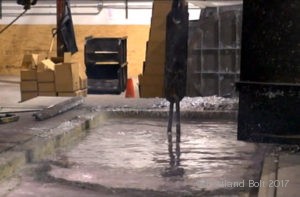 Hot-dip galvanizing is the most common coating for anchor bolts that provides a high degree of corrosion resistance for an economical cost. This process requires anchor bolts to be submerged in molten zinc so that the zinc bonds with the steel of the anchor bolt at a chemical level. Projects that have foundations and anchor bolts exposed to the elements, such as substations or light poles, will predominantly be hot-dip galvanized. It is absolutely crucial that the company performing the galvanizing process utilizes specialized systems to sufficiently remove the excess zinc from the anchor bolt threads without “chasing” (trying to recut) the threads. ASTM F2329, which is the most current galvanizing specification for threaded fasteners, specifically prohibits the manufacturing practice of “chasing threads” in section 5.4.1 of the specification. Manufacturers who chase threads will often accidentally remove all of the zinc coating or even a small portion of the threads themselves in an effort to remove the zinc, potentially weakening the threads. Galvanizers experienced in hot-dip galvanizing fasteners and anchor bolts will typically use centrifugal force to spin the excess zinc out of the threads of galvanized anchor bolts while the zinc is still in a liquid state.
Hot-dip galvanizing is the most common coating for anchor bolts that provides a high degree of corrosion resistance for an economical cost. This process requires anchor bolts to be submerged in molten zinc so that the zinc bonds with the steel of the anchor bolt at a chemical level. Projects that have foundations and anchor bolts exposed to the elements, such as substations or light poles, will predominantly be hot-dip galvanized. It is absolutely crucial that the company performing the galvanizing process utilizes specialized systems to sufficiently remove the excess zinc from the anchor bolt threads without “chasing” (trying to recut) the threads. ASTM F2329, which is the most current galvanizing specification for threaded fasteners, specifically prohibits the manufacturing practice of “chasing threads” in section 5.4.1 of the specification. Manufacturers who chase threads will often accidentally remove all of the zinc coating or even a small portion of the threads themselves in an effort to remove the zinc, potentially weakening the threads. Galvanizers experienced in hot-dip galvanizing fasteners and anchor bolts will typically use centrifugal force to spin the excess zinc out of the threads of galvanized anchor bolts while the zinc is still in a liquid state.
